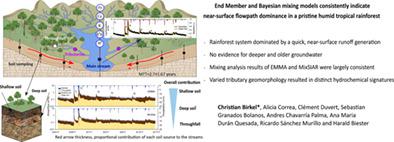当前位置:
X-MOL 学术
›
Hydrol. Process.
›
论文详情
Our official English website, www.x-mol.net, welcomes your
feedback! (Note: you will need to create a separate account there.)
End member and Bayesian mixing models consistently indicate near‐surface flowpath dominance in a pristine humid tropical rainforest
Hydrological Processes ( IF 2.8 ) Pub Date : 2021-03-31 , DOI: 10.1002/hyp.14153 Christian Birkel 1, 2 , Alicia Correa Barahona 1 , Clément Duvert 3 , Sebastián Granados Bolaños 1 , Andres Chavarría Palma 1 , Ana Maria Durán Quesada 4 , Ricardo Sánchez Murillo 5 , Harald Biester 6
Hydrological Processes ( IF 2.8 ) Pub Date : 2021-03-31 , DOI: 10.1002/hyp.14153 Christian Birkel 1, 2 , Alicia Correa Barahona 1 , Clément Duvert 3 , Sebastián Granados Bolaños 1 , Andres Chavarría Palma 1 , Ana Maria Durán Quesada 4 , Ricardo Sánchez Murillo 5 , Harald Biester 6
Affiliation

|
The impacts of forest conversion on runoff generation in the tropics have received much interest, but scientific progress is still hampered by challenging fieldwork conditions and limited knowledge about runoff mechanisms. Here, we assessed the runoff generation, flow paths and water source dynamics of a pristine rainforest catchment in Costa Rica using end member mixing analysis (EMMA) and a Bayesian mixing model (MixSIAR). Geochemical tracer data collected over a 4‐week field campaign were combined with tritium data used to assess potential deeper groundwater flow pathways to the perennial stream. The streamflow composition was best captured using three end‐members, namely throughfall, shallow (5–15 cm) and deeper (15–50 cm) soil water. We estimated the end‐member contributions to the main stream and two tributaries using the two mixing approaches and found good agreement between results obtained from EMMA and MixSIAR. The system was overwhelmingly dominated by near‐surface sources, with little evidence for deeper and older groundwater as tritium‐derived baseflow mean transit time was between 2.0 and 4.4 years. The shallow soil flow pathway dominated streamflow contributions in the main stream (median 39% and 49% based on EMMA and MixSIAR, respectively), followed by the deeper soil (32% and 31%) and throughfall (25% and 19%). The two tributaries had even greater shallow soil water contributions relative to the main stream (83% and 74% for tributary A and 42% and 63% for tributary B). Tributary B had no detectable deep soil water contribution, reflecting the morphology of the hillslope (steeper slopes, shallower soils and lower vegetation density compared to hillslope A). Despite the short sampling campaign and associated uncertainties, this study allowed to thoroughly assess runoff generation mechanisms in a humid tropical catchment. Our results also provide a first comparison of two increasingly used mixing models and suggest that EMMA and MixSIAR yield comparable estimates of water source partitioning in this tropical, volcanic rainforest environment.
中文翻译:

末端成员和贝叶斯混合模型始终表明原始湿润热带雨林中的近地表流径优势
森林转化对热带地区径流产生的影响引起了人们的极大兴趣,但科学的进步仍然受到挑战性的野外工作条件和对径流机理的有限知识的阻碍。在这里,我们使用末端成员混合分析(EMMA)和贝叶斯混合模型(MixSIAR)评估了哥斯达黎加原始雨林集水区的径流产生,流径和水源动态。在为期4周的野外活动中收集的地球化学示踪剂数据与data数据结合使用,data数据用于评估通往多年生河流的潜在深层地下水流动路径。最好使用三个末端成员来捕获水流成分,即穿透水,浅水(5-15厘米)和深水(15-50厘米)。我们使用两种混合方法估算了最终成员对主流和两个支流的贡献,并发现从EMMA和MixSIAR获得的结果之间有很好的一致性。该系统以近地表水源为主,几乎没有证据表明更深和更老的地下水,因为base衍生的基流的平均传播时间在2.0年到4.4年之间。浅层土壤流径占主流水流的主要部分(分别基于EMMA和MixSIAR的中值分别为39%和49%),其次是深层土壤(32%和31%)和穿透水(25%和19%)。相对于主流,这两个支流的浅层土壤水贡献更大(支流A分别为83%和74%,支流B为42%和63%)。支流B没有可检测到的深层土壤水贡献,反映了山坡的形态(与A山坡相比,坡度更大,土壤更浅,植被密度更低)。尽管采样活动很短且存在不确定性,但这项研究仍可以彻底评估潮湿热带流域的径流产生机理。我们的结果还提供了两个越来越多使用的混合模型的首次比较,并表明EMMA和MixSIAR在这种热带,火山雨林环境中产生了可比的水源分配估算。
更新日期:2021-04-19
中文翻译:

末端成员和贝叶斯混合模型始终表明原始湿润热带雨林中的近地表流径优势
森林转化对热带地区径流产生的影响引起了人们的极大兴趣,但科学的进步仍然受到挑战性的野外工作条件和对径流机理的有限知识的阻碍。在这里,我们使用末端成员混合分析(EMMA)和贝叶斯混合模型(MixSIAR)评估了哥斯达黎加原始雨林集水区的径流产生,流径和水源动态。在为期4周的野外活动中收集的地球化学示踪剂数据与data数据结合使用,data数据用于评估通往多年生河流的潜在深层地下水流动路径。最好使用三个末端成员来捕获水流成分,即穿透水,浅水(5-15厘米)和深水(15-50厘米)。我们使用两种混合方法估算了最终成员对主流和两个支流的贡献,并发现从EMMA和MixSIAR获得的结果之间有很好的一致性。该系统以近地表水源为主,几乎没有证据表明更深和更老的地下水,因为base衍生的基流的平均传播时间在2.0年到4.4年之间。浅层土壤流径占主流水流的主要部分(分别基于EMMA和MixSIAR的中值分别为39%和49%),其次是深层土壤(32%和31%)和穿透水(25%和19%)。相对于主流,这两个支流的浅层土壤水贡献更大(支流A分别为83%和74%,支流B为42%和63%)。支流B没有可检测到的深层土壤水贡献,反映了山坡的形态(与A山坡相比,坡度更大,土壤更浅,植被密度更低)。尽管采样活动很短且存在不确定性,但这项研究仍可以彻底评估潮湿热带流域的径流产生机理。我们的结果还提供了两个越来越多使用的混合模型的首次比较,并表明EMMA和MixSIAR在这种热带,火山雨林环境中产生了可比的水源分配估算。











































 京公网安备 11010802027423号
京公网安备 11010802027423号